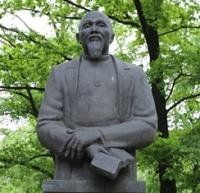You are here
Bust of Turmagambet Izteleu uly.

Information tour in the cities of Kazakhstan.
“And the one we call music
For no better name
Will it save us?”
Akhmatova A. A.
A trip from Petropavlovsk to Almaty.
The monument to the repressed Kazakh akyn, a translator, a native of the Kyzylorda region, Turmagambet Iztleleuly, is located in Sosnovy Square along Kabanbay batyr street, between the streets of Seyfullin Nauryzbay batyr.
It was established on November 2, 2007 for the 125th anniversary of the repressed akyn, who was shot by the NKVD in 1939.Turmagambet Iztleley (1882 - 1939) is a native of the Kyzylorda region. Kazakh akyn, translator. He studied at the aul school, at the Mir Arab madrasah (1896 - 1899) and at the Kokeltash madrasah (1899 - 1905) in Bukhara, where he met S., the future major writer of Central Asia. Aini. Friendship with Aini had a significant impact on the formation of the worldview of Turmagambet: he became an active member of the literary circle.
During his studies at Iztleuly Madrasah, he thoroughly studied Arabic, Persian and Turkish. From 1905 to 1925 Iztleuli was a teacher in aul school, worked at the Commissariat of Public Education of the Kazakh SSR (1936 - 1937).
At the age of 14, he wrote his first fable, The Black Beetle, at 18, his first poem, The Dekhkanin Mardi. He created ten poems, among them the poems "The Wisest Elder", "Captive Girl", "Rau-abanu" and others. Iztleuly brought his poems written on the basis of book plots to Kazakh reality.
He did not limit himself, like some Kazakh poets, to retelling oriental plots, but creatively reworked the already known conflicts in his romantic and fantastic poems, and often reflected real life with great emotional strength.
He supported the national liberation movement of 1916 in Kazakhstan, which sang in the Tolgau "An alarming haze covered the Earth" (1916). I wrote a lot about the revolution 1917, about the party. In the poems “Good luck to you, brother Council!”, “The Lark nested in the wool of a sheep” Iztleleuly urged his people to participate in the renewal of life.
In the 20s. in the work of Iztleula a special upsurge is noted. His works are widely known. He became a singer of his people, singing free flowering Kazakhstan. In 1934, the First All-Union Congress of Soviet Writers was held.
In June of that year, the First Congress of Writers of Kazakhstan was held, which considered the status and objectives of Kazakh literature. People’s akyn Iztleuly was invited from South Kazakhstan to this congress as a delegate.
Turmagambet Iztleuly also participated in the 1st republican rally of folk talents (1934). During these years, the poet pays tribute to the talents of B. Maylin, S. Seifullin, S. Mukanov, I. Zhansugurov, Zhambyl. Due to the appearance in the republic of the works of A. Pushkin, M. Lermontov, N. Gogol, T. Shevchenko, Sh. Rustaveli and others translated into the Kazakh language, a lot of poems dedicated to poets and writers of neighboring nations appeared in the work of Iztleula.
A considerable part of the poet’s artistic heritage is made up of rubyes, lyric poems, aphorisms, fables, and improvisations. His work is diverse in scope and extensive in its coverage of the problems of contemporary reality.
In any of his works there are sincerity of feelings and thoughts. He owns the Kazakh translation of Firdousi’s poem “Shahnameh”, part of which, “Rustem-Dastan”, was published in 1961 as a separate book. Turmagambet's works are included in collections in the Kazakh language: "Poets of Three Centuries" (1965), "Poets of Five Centuries" (1985), came out as separate books.
Authority:
https://infourok.ru/otey-batir-istoriya-kazahstana-2986341.html
Photos
Alexander Petrov.







